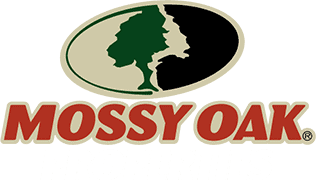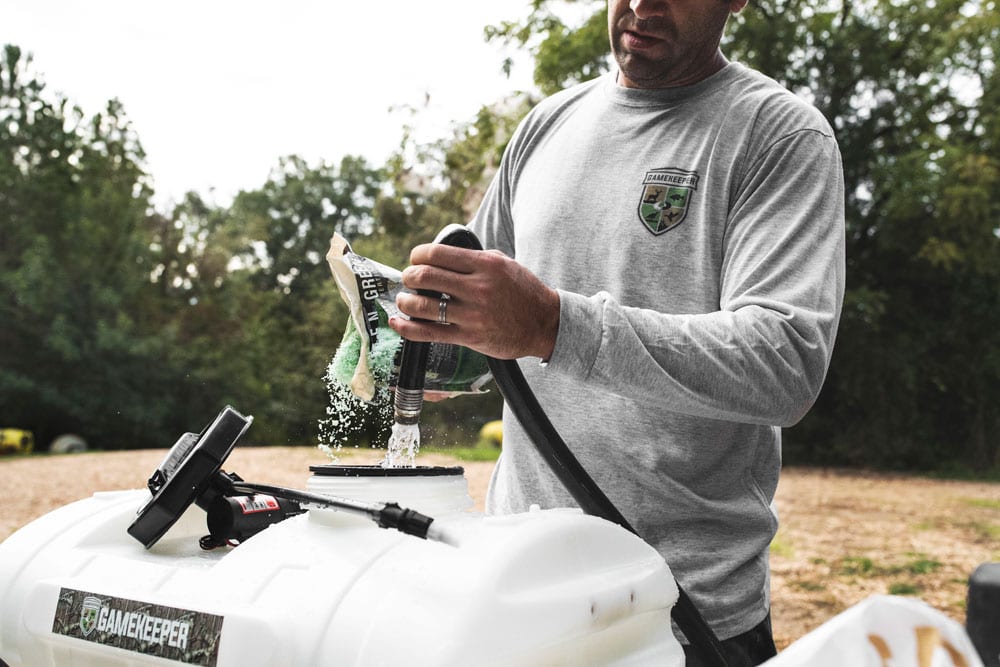provided by John E. Phillips
Austin Delano is a wildlife and habitat consultant at Mossy Oak BioLogic. Delano has been an avid hunter all of his life and always has enjoyed studying and learning how to take deer, turkeys and other wildlife but also how to provide more food and nourishment for the wildlife on the lands he hunts. Right now, we’re only a few weeks away from the beginning of bow season in many states, so what can hunters and landowners plant immediately in hunting food plots?
PLANTING FOR EARLY BOW SEASON

What should we plant now to get ready for early bow season?
Delano: You have several choices, depending on where you live, and how you plan to use your food plots. If you want to concentrate on food plots for early archery season, you need to plant crops that are really attractive to deer as soon as they come out of the ground, like cereal grains and winter peas. One of our favorite blends to use is Mossy Oak BioLogic’s Outfitter’s Blend that contains winter peas, cereal grains and early-maturing brassica seeds. If you want to extend that plot to continue to feed wildlife through the winter months, BioLogic suggests you add Winter Bulbs & Sugar Beets or BioLogic’s Final Forage, a blend of seeds, into your Outfitter’s Blend to bulk-up your food plot with some later-season brassicas. If your land has proper soil moisture, these seeds generally will start coming out of the ground in 4 to 7 days.
Do we need to add any fertilizer to these seed blends?
Delano: Definitely. We always recommend that you fertilize according to the soil test you take before you plant. Without a soil test, we suggest you put 350 to 400 pounds of 13-13-13 fertilizer per acre. We also use BioLogic’s Forage Max fertilizer, a liquid fertilizer of liquid nitrogen, phosphorous, potassium and calcium, that hunters and landowners can apply right as the crop comes up. This fertilizer helps the plants grow quicker and produces a bigger crop faster because the plants take in the liquid fertilizer through the leaves rather than through their root systems.
Two other plantings that you can use right now, especially for those little hidey-hole spots or what we call hunting spots to be planted in the woods for deer to feed on before they go to major food plots, are Hot Spot and Hot Spot Plus – both no-till plantings. The Hot Spot Plus comes with a water-soluble fertilizer packet of M.E.E.N. Green inside the seed packet. The Hot Spot Plus is designed for a hunter to create a small green field out in the woods where he may not be able to get tractor-sized equipment into the field to till the soil. He may only be able to get into one of these hidey holes with an ATV or by walking in on a trail and using a battery-powered weed eater, a leaf blower and a rake. These two blends are made to be put in with a minimal number of tools and grow well even in shade.
We suggest the landowner or the hunting-club members clear the area of any weeds and vegetation on the site and make sure they scratch up or rototill the ground. Then they’ll get good seed-to-ground contact when planting Hot Spot or Hot Spot Plus. Also make sure that all the leaves, sticks and dead vegetation are cleared off the place being planted. Breaking the soil up and dragging it around will give some texture to it. Then you can broadcast Hot Spot and lightly cover it by dragging it or raking it into the soil. These two Mossy Oak blends are productive choices to create feeding spots in hard-to-get-to places in the woods. You can mix Hot Spot Plus with water and spray it on the plants coming up. Although you can spray Hot Spot Plus any time after germination (when the plants come out of the ground), the best time to use that liquid fertilizer is 10-15 days after the plants come out of the ground. That M.E.E.N. Green, water-soluble fertilizer really will enhance the growth of these plants. I’m often asked, “How long will a Hot Spot food plot last?” That really depends on the deer density on the property you’re hunting, and how big the plot is. However, usually, this blend of seeds will last well into the winter months.

HAVING BIGGER GREEN FIELDS
So far, we’ve been talking about hidey-hole and small-plot green fields for early bow season. But we also want to have some larger green fields that will attract and feed deer from bow season all the way through to the end of the deer season. What should we plant in larger green fields?
Delano: We like to break our green-field plantings down to the time of year that you want to hunt them. So, we suggest that instead of planting one crop in your green fields, you consider dividing the green field into two plots, and plant Hot Spot or Hot Spot Plus and/or Outfitter’s Blend in one half of your green field for early-season hunting, whether that’s bow or gun. Then plant the other half of the field for the middle and later portion of deer season with Final Forage (radish, rape and turnip varieties) that provides massive amounts of forage, Winter Bulbs & Sugar Beets, and/or New Zealand Maximum (100% New Zealand highly-palatable brassicas developed by New Zealand’s venison industry to promote rapid weight gain, optimum deer health and massive antler growth). These are our most popular late-season blends and provide more of BioLogic’s late-season brassicas and other seeds that will feed and attract your deer from the middle to the end of deer season. Our late-season blends have radish seeds in them. By planting two crops in the same field (depending on the size of the field and the deer density) of highly- nutritious, attractive plants that will grow from before the beginning of bow season, you’ll provide food for a long time.
Paying Attention to the Wind When Going to or Coming Away from a Green Field
One of the problems that hunters have when they hunt green fields is that they may go to a green field with a bad wind to hunt that green field or the route to the green field may be so open that the deer can see or hear them coming. What does Mossy Oak BioLogic offer to solve this problem?

Delano: You’re absolutely right. A hunter’s entrance and exit to the green field needs to be protected as much as possible. Deer pay attention to and will spook off your green field before you arrive at your stand site, if the wind is at your back instead of at your face. So at BioLogic, we believe in planting screens that help to hide the hunter’s entrances and exits to green fields and to conceal ground blinds.
We offer a product named Blind Spot that can be planted on either side of the trail you walk to reach your tree stand or shooting house on or near the green field. This product really needs to have been planted back in June to make sure that it grows tall and thick. You also can use Blind Spot to break up a large green field and make each part of the green field appear to be a smaller green field. Or, you can plant Blind Spot, if your green field is close to a major road to keep the people driving down the road from seeing the deer in your green field.
Blind Spot is a very tall variety of forage sorghum. With good soil conditions and growing conditions, this sorghum can grow 8-12 feet tall. It also stands up to winter weather really well, is easy-to-grow and lasts throughout all or most of deer-hunting season. Except for the Deep South, you’re probably too late to plant this crop this year here in September. However, Blind Spot also has another positive benefit to the hunter. Generally, you have to plant this crop every year; however, it has a big seed head that produces a lot of seed that may self-generate. The seeds from the sorghum provide another food source for songbirds and ground-nesting birds like quail and turkeys. So, you may get some regeneration from those big seed heads, but, more than likely, you’ll want to plant Blind Spot every year.
DOUBLING DOWN ON DEER AND TURKEYS WITH YOUR PLANTINGS
If the size of the property we’re hunting and the amount of money we have to spend on plowing, liming, fertilizing and planting is minimal, then how can we put in one food plot that will help feed deer and turkeys, produce a crop from the beginning of bow season until the end of rifle season for deer, and still yield a good crop of food for our turkeys and turkey poults? Which BioLogic product can span the whole gamut of deer and turkey seasons?

Delano: For a food plot that will feed deer and turkeys all year long, I suggest you plant Mossy Oak BioLogic Non-Typical Clover. It’s a fast-establishing, aggressive, large leaf white clover that’s cold tolerant, palatable, durable and browse tolerant for 3-5 years if properly mowed, fertilized and weed controlled using herbicides.
This perennial blend of New Zealand red and white clovers features large succulent seeds and chicory that is hardy and drought-resistant. Clover Plus seeds, from the Midwest to the Deep South, is a fall planting of clover. One of the reasons for planting clover in the fall is that’s usually when states receive some of their best rains. We recommend planting clover with a cereal grain crop like Green Patch Plus with its New Zealand brassicas and clover that establish quickly to provide food through the end of hunting season and/or Outfitter’s Blend. The clover won’t come screaming out of the ground like Green Patch Plus or Outfitter’s Blends will. But by combining the clover with the Outfitter’s Blend and/or Green Patch Plus, those plantings will give the deer plenty of food to feed on until the clover becomes well established and will give some protection to the clover while it’s growing. If the U.S. has an extended fall with really good growing temperatures and moisture in the soil, you may get a good growth out of your clover when it’s planted in the South. But if areas experience a couple of early frosts, and winter comes on quickly, that first planting may not look like much. However, by springtime, that clover will be abundant for turkey season.
To plant a green field to provide food for both deer and turkeys from the beginning of bow season to the end of turkey season, BioLogic suggests a mixture of Green Patch Plus and either Non-Typical Clover or Clover Plus planted all at the same time. When we’ve cut open the craws in turkeys that have been harvested in the spring, many times their craws will be packed with clover and not just with bugs and insects.
In good climates, clover may last for several years and be available for deer in the early bow season through the end of turkey season. If you live in an area where there’s snow, the clover may go dormant for a couple months but then return in the early spring. The same problem happens during a drought when the weather is super-hot, and the ground is very dry. You may lose the clover for a couple months, but once the weather cools down some and moisture is back in the ground, the clover generally will rebound really strong. The main thing you have to do with clover as far as maintenance goes is to keep the weeds out of the clover by using some type of herbicide.
PLANTING FLOODED AND DROUGHT REGIONS
As mentioned, when you plant clover and the area has snow or a drought, that clover may vanish for a couple of months but then return after those severe weather conditions have passed. In many sections of the South, especially this past year, we’ve had floods and droughts. I know in much of the West and Southwest numbers of floods have occurred. If we experience flooding conditions in the spring and fall, what do we need to plant? On the other end of the spectrum, what crops do you suggest to plant in drought conditions?

Delano: BioLogic has had good results with Non-Typical Clover getting its feet wet and going underwater. If it remains underwater too long, you may lose that crop. However, even if an area gets flooded and the Non-Typical Clover does stay under water for several days, we’ve had pretty good luck with that crop coming back. On the flip side of the weather, people who have to deal with severe droughts have had good luck with some of BioLogic’s brassicas, like the Deer-Radish, which are some of the most drought-resilient and highly-nutritious plants we have for the fall. If the deer radishes have enough soil moisture to germinate, they’ll hold up about as well as any crop you may hope to have. Usually if those radishes, which provide forage and long, sweet roots, get one good rain after the seeds are planted, they’ll often be able to hold up during a drought until the next rains arrive.
Another seed that we put in our Clover Plus Blend is chicory, a perennial, but it may be slow to start growing. If you live in an area that has infrequent rainfall, chicory can be a great planting because it’s very deep-rooted and can pull moisture and nutrients from deep down in the soil.
The good news too is that Mossy Oak BioLogic has some additive bags that you can mix in with whatever crop you plant. For instance, if you plant winter wheat or any type of wheat, and you’re concerned about droughts, you can get an additive bag of chicory and mix that in with your wheat seed before you plant it. If you get hit by a drought, that chicory will rebound and produce a good stand of deer food when the spring of the year comes around, the heat’s gone, and you have rains bringing moisture back to the soil.
To get more information on Mossy Oak BioLogic Plantings, when to plant and what to plant for the area you live in, go to www.plantbiologic.com. We also have a “GameKeepers Magazine” that comes out quarterly that’s for people who farm for wildlife, and a GameKeepers TV show that deals with subjects on how to better manage your property for wildlife – whether you have 40 acres or 40,000 acres. “GameKeepers TV” airs on the Outdoor Channel. We also have plenty of information on our Mossy Oak GameKeepers YouTube channel.




